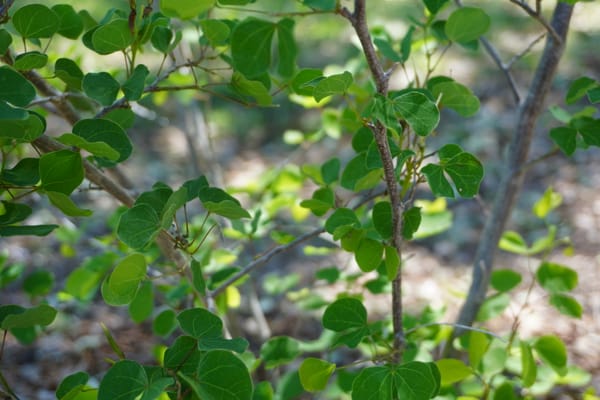Yaupon Holly (Ilex vomitoria)
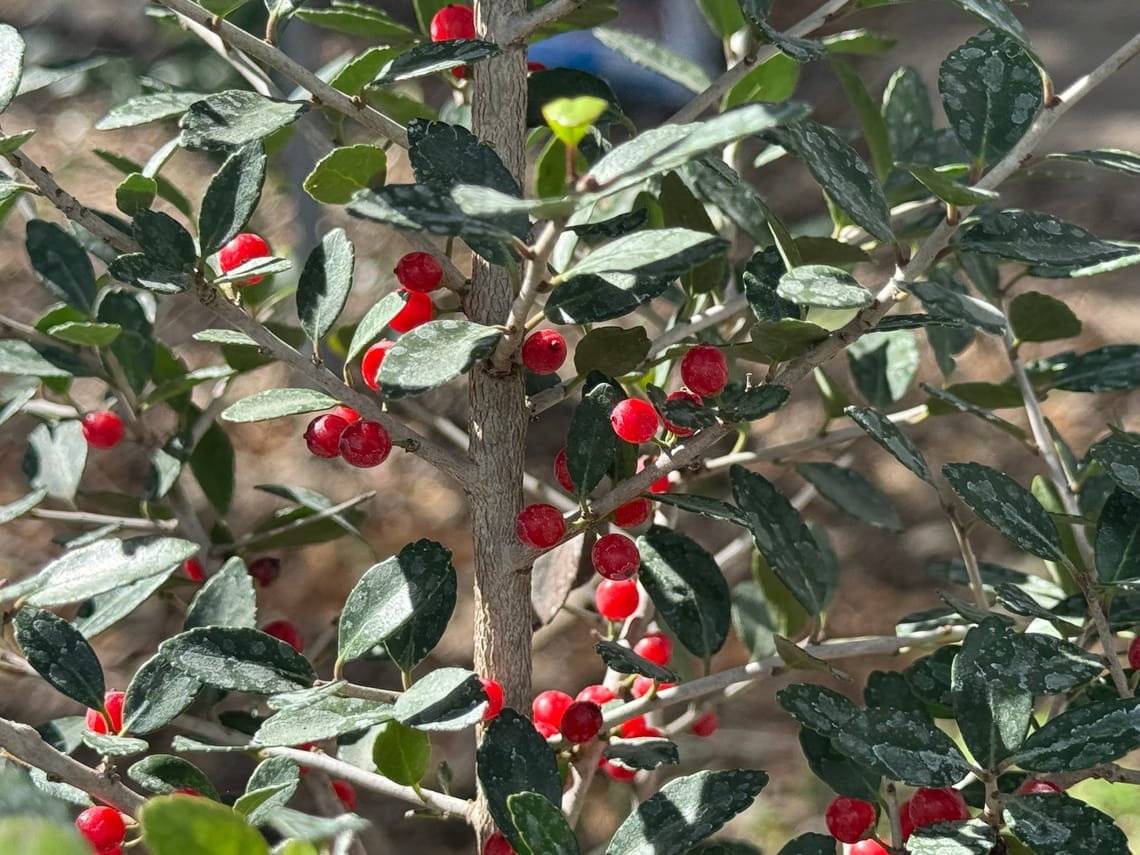
The Yaupon Holly is an evergreen Texas native shrub or small tree that's become one of the most commonly used plants in landscapes around the state.
And for good reason! It's highly versatile, withstanding full sun or tolerating full shade, and drought-resistant, but it doesn't mind being flooded occasionally.
It's also a great potential living fence; as an evergreen, it keeps its leaves through winter, and female plants fill out further in fall to winter, producing bright red berries (which are toxic to humans but a late winter food source for wildlife).
The Yaupon Holly leaves can be used to make tea, and it is the only plant in its region whose leaves are known to contain caffeine.
It can be planted and maintained as a specimen small tree (requiring heavy pruning) or around edges left to its own devices to create privacy, where it will grow more shrubby.
🎥 Watch on YouTube
Common Name(s): Yaupon Holly, Yaupon
Latin Name: llex vomitoria (ILL-EX VOM-I-TOR-IA)
Height: Rarely taller than 25’, although it has the potential to be 45' tall. Most often between 12 - 25'.
Soil Conditions: Moist or well-drained, sandy, loamy, clay, limestone, or gravelly soils. It can tolerate poorly drained soils as well. It is a very versatile plant. It doesn’t mind being occasionally flooded.
Water: Can tolerate both drier and moister conditions. Highly resilient.
Light: Full Sun to full shade. The more sun for female plants, the greater the potential fruit.
Family: Aquifoliaceae (Holly Family)

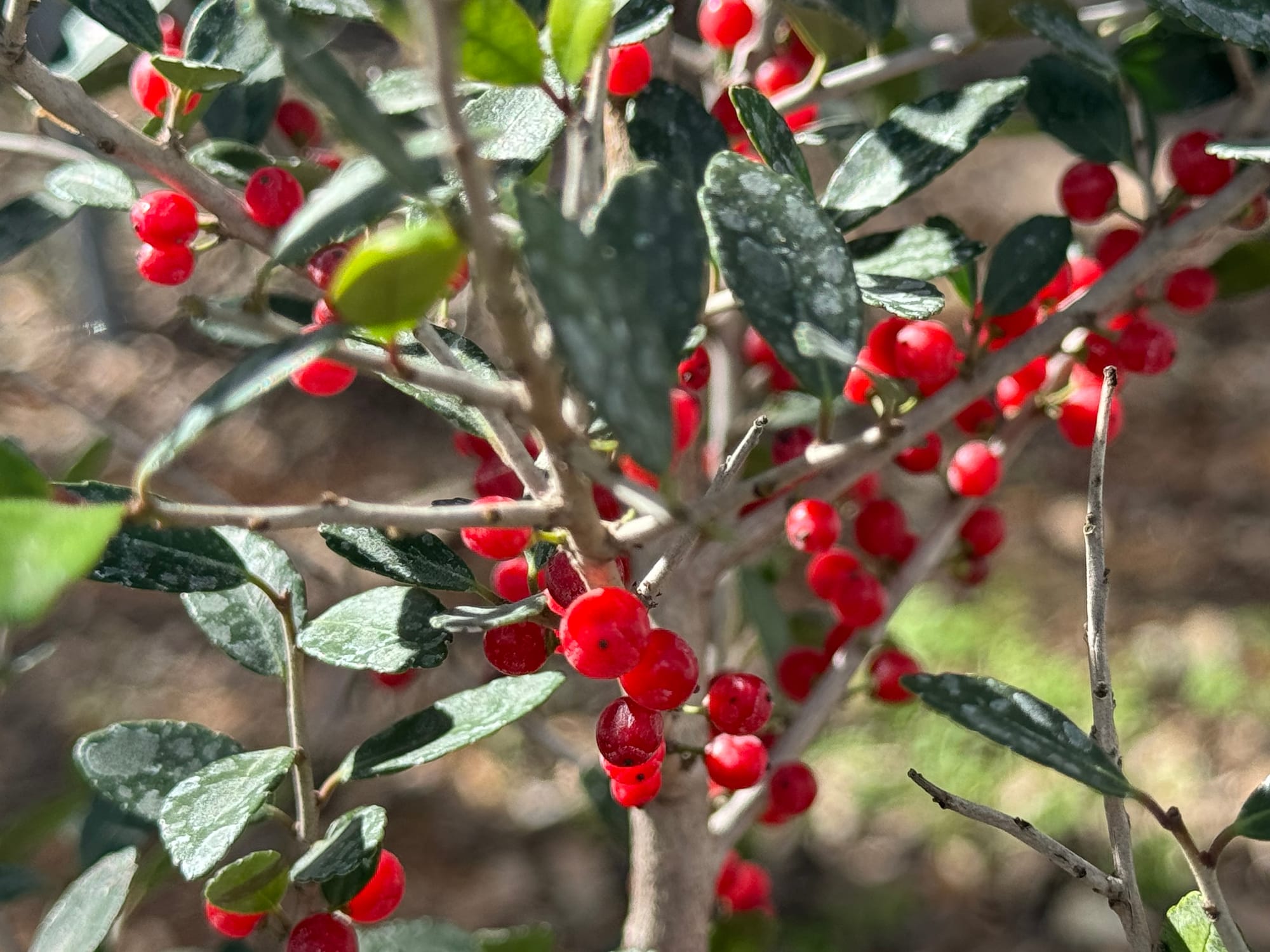
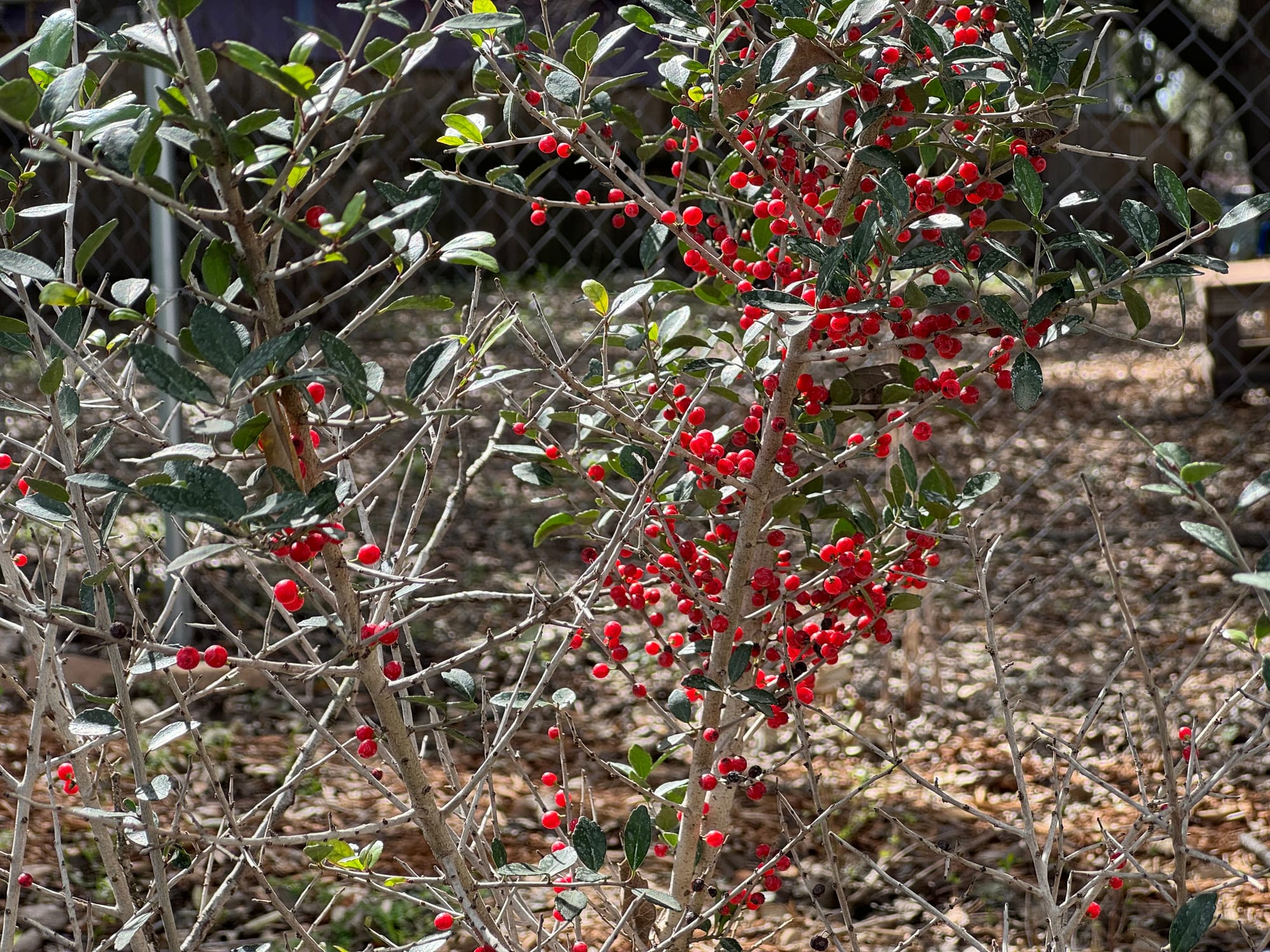
Female Yaupon Holly in my Landscape
Distribution:
Where is the Yaupon Holly native?
The Yaupon Holly grows throughout the southeastern U.S., up to Virginia, and down through East Central Texas. It is found in wooded bottomlands or wooded canyons.
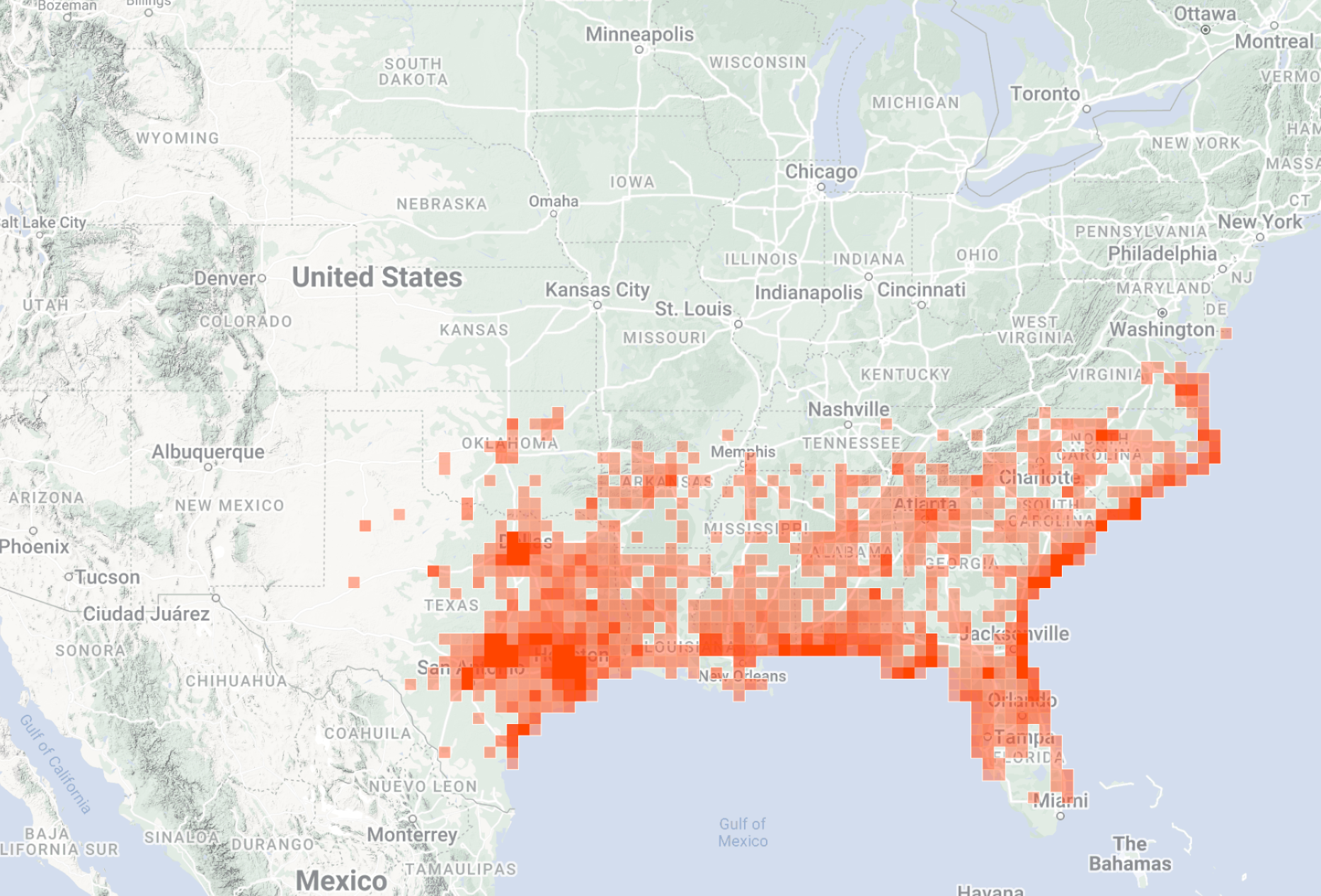
It is described to be found “anywhere” in East Texas, probably because of greater moisture, and more often near creeks in Central Texas, where it’s drier.
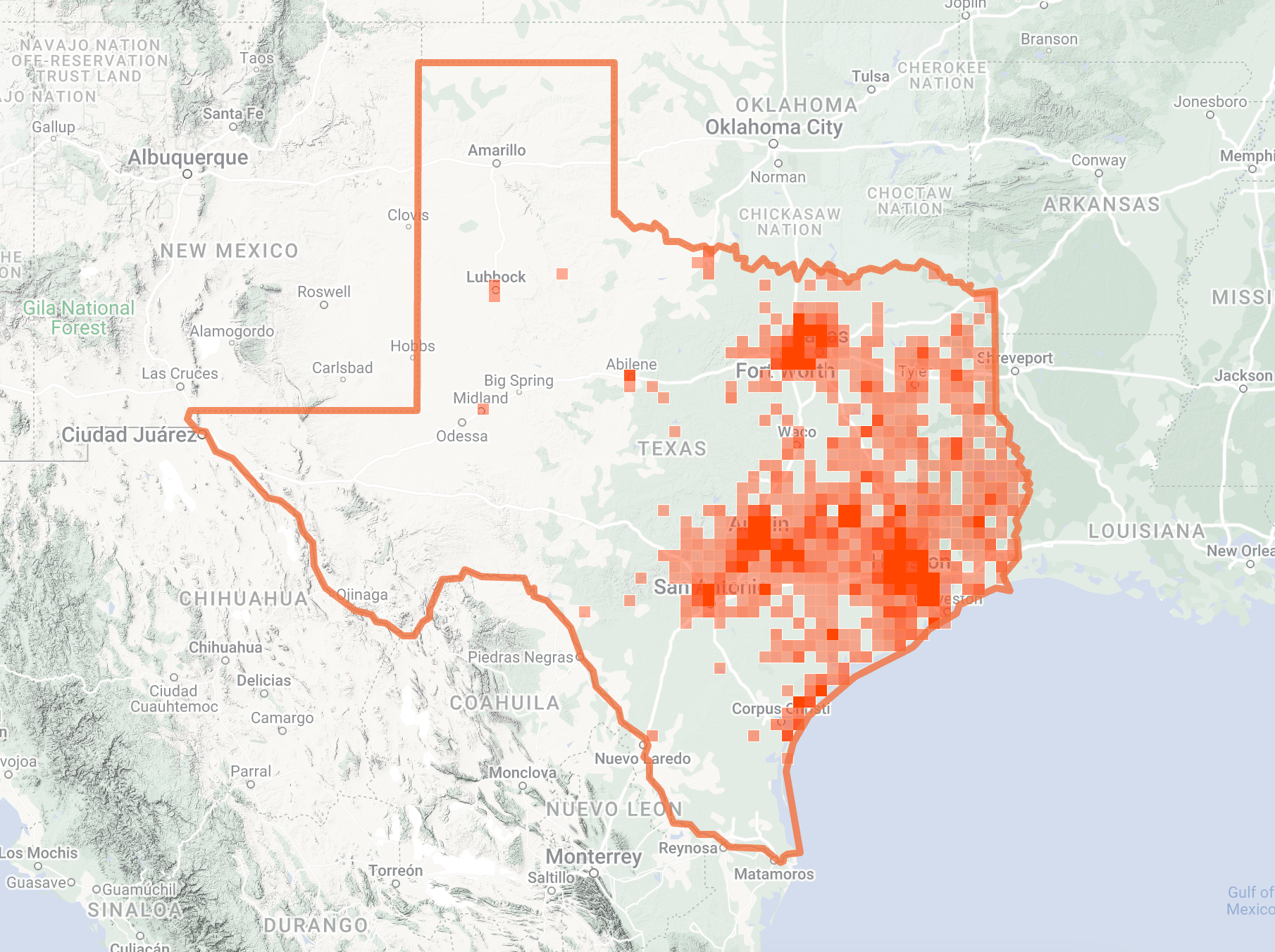
The Benefits of Yaupon Holly:
For Your Landscape:
- Living Fence - The Yaupon Holly is often used as a hedge. It is also a great potential living fence as it should grow dense and retain its leaves through winter as an evergreen.
- Versatility - You can plant a Yaupon Holly in various locations. It can handle full sun to full shade and moist to dry soil. This is probably why it's become very commonly used by landscapers throughout the state.
- Wildlife Attractant - The berries are a food source for various wildlife, and the nectar of the flowers attracts insects. It's also an excellent nesting tree.
For Wildlife:
- Food Source - Fruits are eaten by various birds: bobwhites, doves, robins, cedar waxwings, bluebirds, jays, and mockingbirds. Squirrels, opossums, rabbits, and foxes eat the berries as well. However, the fruits aren’t typically eaten until late winter (when little else is available) when the fruit has potentially fermented.
- Attracts Insects - The flower nectar and pollen attract insects.
- Nesting Tree - The Yaupon Holly is an excellent nesting tree for birds given the density of it's branches as it grows.
- Larval Host - The Yaupon Holly is a larval host for the Henry's Elfin butterfly. Most of the Henry's Elfin butterfly observations are made from February to April in Texas, peaking in March if you'd like to look out for them once you plant your own, Yaupon Holly.
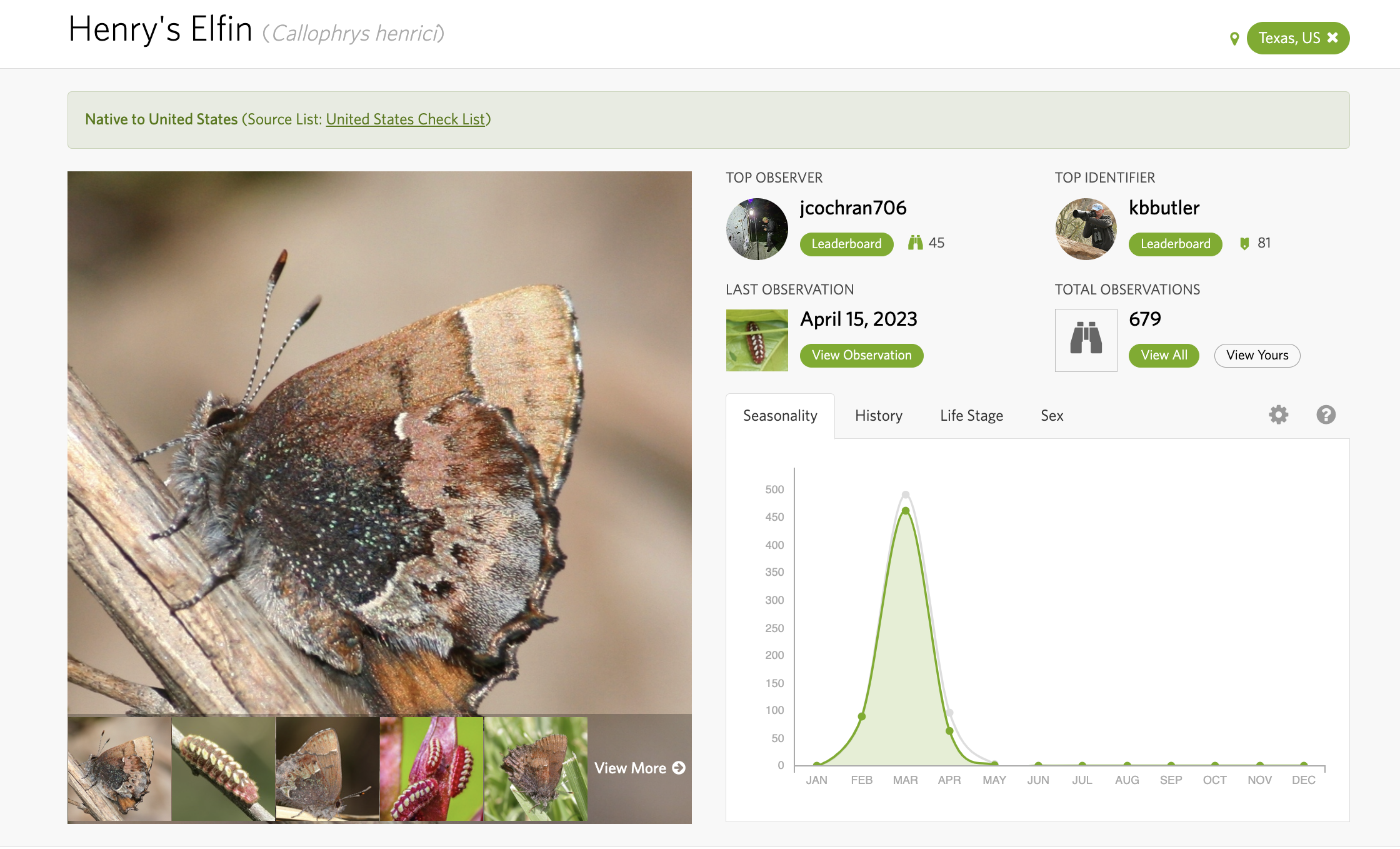
Planting & Care:
Where to Plant: Here's where I believe you should consider planting Yaupon Holly in your landscape.
- Where You Want a Privacy Screen - This should be the highest priority because a Yaupon Holly is a very versatile plant. So, making the light and water requirements work shouldn't be an issue. I've planted two Yaupon Hollies in my landscape thus far. One is planted within a basin designed to retain water runoff and the other is intended to be a privacy screen between our back porch and the patio of our guest house. Each is planted in variable sun/shade conditions. However, the Yaupon Holly is slow-growing, so if you want this plant to offer you privacy, it might be worth investing in a larger size upon purchasing.
- Moister Points in Landscape - This is another virtue of the Yaupon Holly. It doesn't mind occasional flooding. So, if you need privacy somewhere that a lot of water accumulates or perhaps is of a gutter downspout or near a run-off area, don't hesitate to plant the Yaupon there.
- Shade / Partial Shade Understory - The Yaupon can get dense and grow large to fill in gaps in your understory. We have a mature Anacua tree that we love in the backyard of our guest house, however, there's still a large gap that we'd like to have filled to offer more privacy to our guest house patio.
- Plant Multiple (Male & Female Plants) - The male and female flowers are on separate plants, and only the female plants bear fruit, so you'll need both if you're interested in having Yaupons that bear the bright red winter berries.
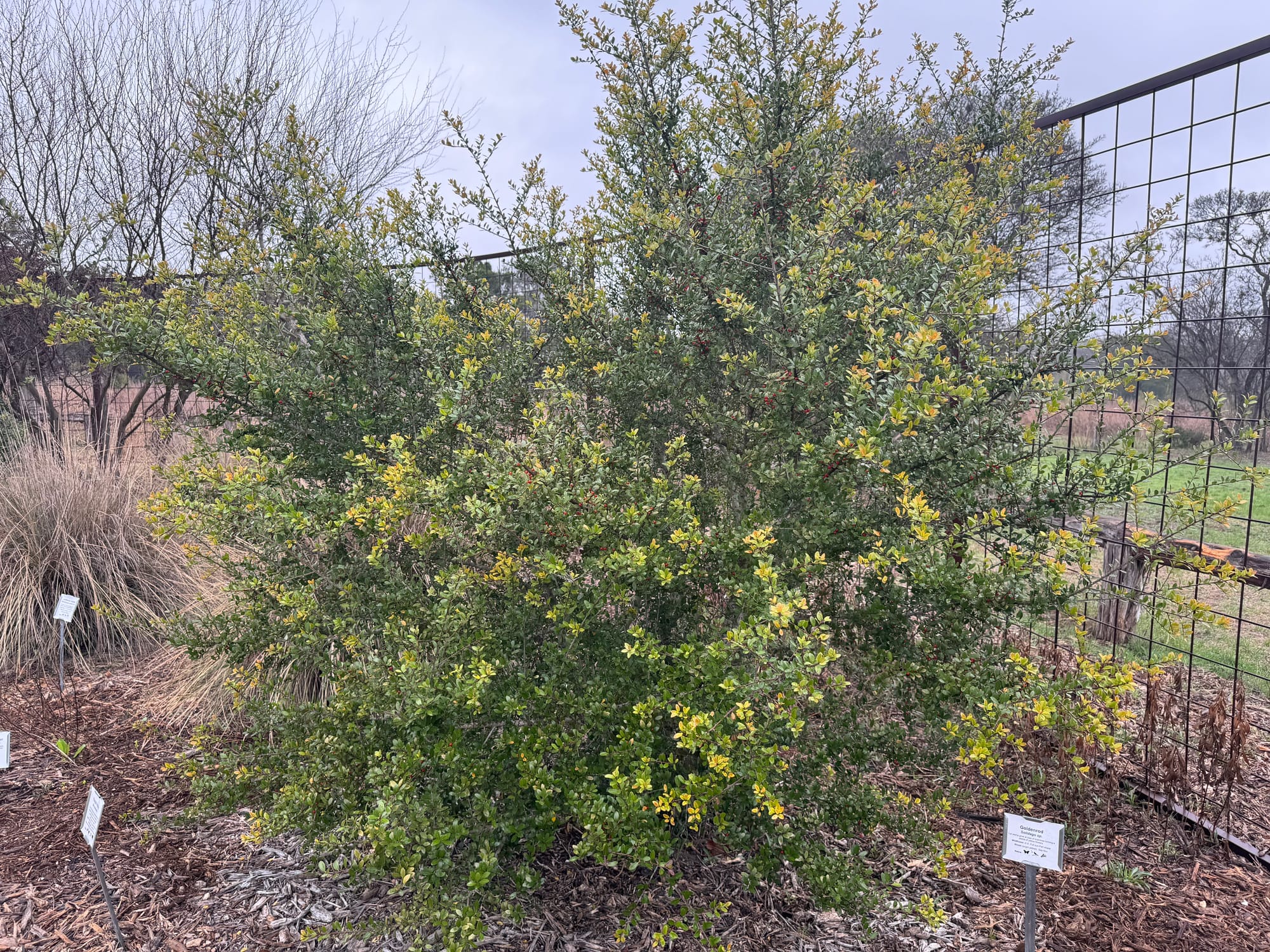
Care/Maintenance: To get the effect of a “tree,” considerable pruning efforts are required, although Yaupon has been known to tolerate this very well. Otherwise, it will appear more shrub-like. The level of "care" or maintenance you'll need to provide to your Yaupon Holly will depend on your priorities.
You must prune heavily in later winter if you want a small tree. If you don't mind a more wild shrub, leave it be! You can also find a balance between those two if you prefer to do some light shaping now and again.
Companion Plants: There's a long list of potential companions to the Yaupon Holly. You can plant it with a Possumhaw Holly, very similar, but the Possumhaw is deciduous so it will lose it's leaves each winter.
The Yaupon Holly is also partners well with:
- Carolina Buckthorn
- Spicebush
- American Beautyberry
- Pigeon Berry
- Turk's Cap
- Agarita
- Texas Buckeye
- Mexican Buckeye
- Arkansas Yucca
- Prairie Phlox
- Ebony Spleenwort
Seasons: What to Expect
Spring: In Spring, the tiny white flowers of the Yaupon Holly should begin to bloom in clusters.
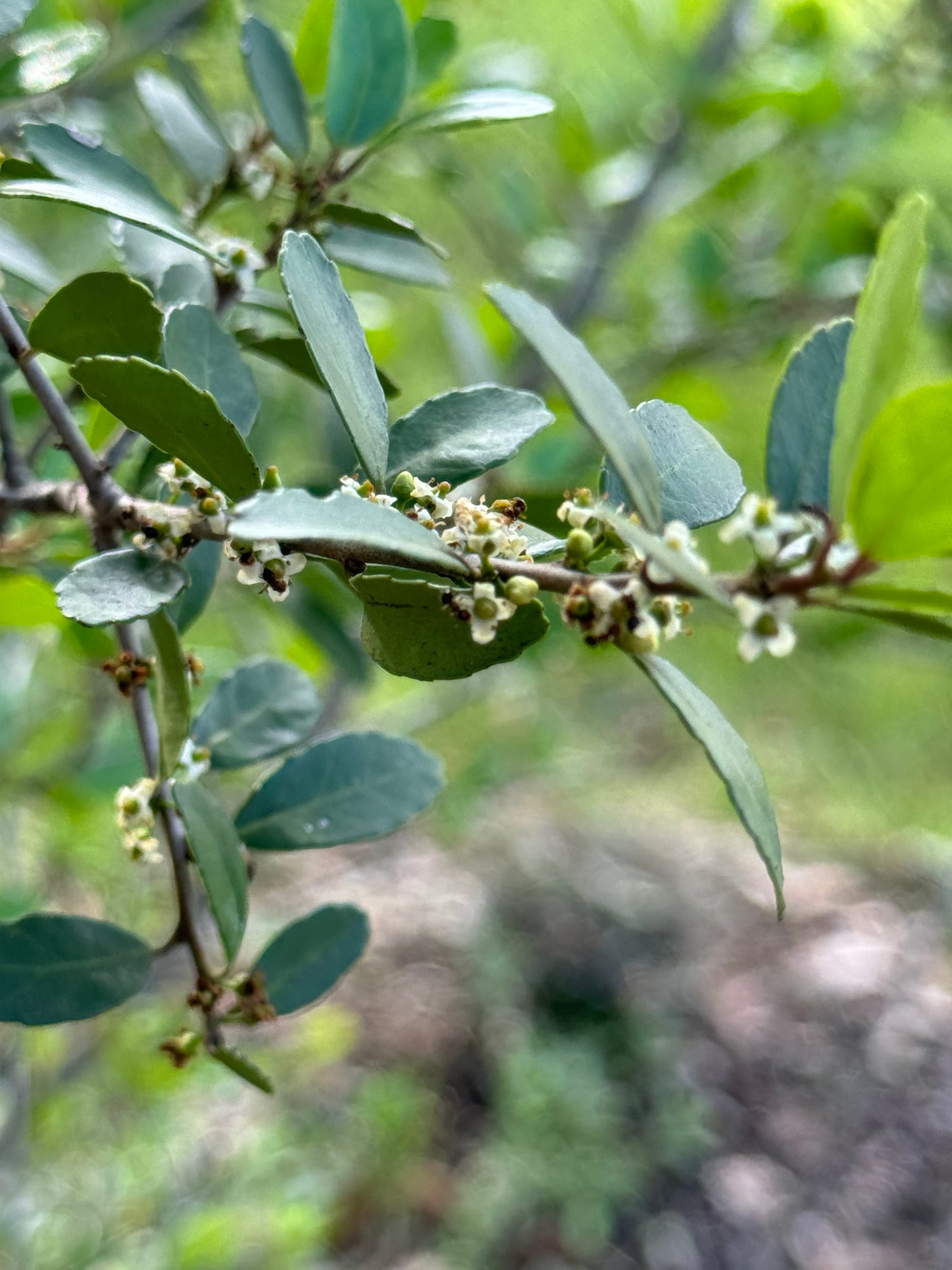
Summer: Yaupon continues to bloom throughout summer, but as summer progresses, blooms will lead to begin to lead to berries (if you have a female plant with a male plant nearby).
Fall: Bright red fruits will appear on the Yaupon Holly, starting as early as late summer. By the end of fall, approaching winter, the Yaupon Holly should be fully fruited.
Winter: The Yaupon Holly is evergreen, so it will retain its leaves through as well as the newly formed berries. Berries will remain on the Yaupon through winter until they are eaten or drop to the ground.
And, of course, a freeze-hardy plant, there's no concern for Yaupon Holly's performance during a Texas hard freeze.
Medicinal/Edible Uses:
- Leaves - The leaves of the Yaupon Holly can be made into a highly caffeinated tea that resembles Yerba Mate. It’s the only wild tea in its native region that contains caffeine! The leaves can be gathered (young and/or old) in any season and roasted to be later brewed.
- Theobromine - Yaupon contains theobromine (a mood-boosting alkaloid also found in chocolate). Yaupon also appears to be very high in antioxidants and polyphenols.
Propagation:
- Cuttings - Growing from cuttings seems to be the most promising (albeit still inconsistent) means of propagating Yaupon Holly. Recommended to take semi-hardwood cuttings in late fall and treat with rooting hormone. Reportedly, we can see a 50% rooting success rate after 4-8 weeks. Yaupon Holly is slow growing, so if you're considering growing your own, be ready for a long-term commitment to get them to the size you'd like. Might just be worth buying, unless you're very patient.
Yaupon Holly FAQs:
- What is the Yaupon Holly good for? The Yaupon Holly is particularly good for providing a living fence or privacy screen. The only consideration here is it's slow rate of growth. Buy a larger plant to start.
- Are Yaupon Holly berries poisonous? Yes, like all berries in the holly family, the yaupon berries are highly toxic. But, while humans can't consume them, wildlife seems to enjoy them.
- Is Yaupon Holly fast-growing? No, the Yaupon Holly is a slow-growing plant. The Yaupon Holly might grow roughly one foot per year depending on conditions.

Sources:
Along with my own experience working with Yaupon Holly in my landscape and learning from my observations out in Texas' natural places, here are all the books and resources that I consulted in producing this page:
📚 Books
- Edible and Useful Plants of the Southwest: Texas, New Mexico, and Arizona by Delena Tull
- Foraging Texas: Finding, Identifying, and Preparing Edible Wild Foods in Texas by Eric M. Knight and Stacy M. Coplin
- How to Grow Native Plants of Texas and The Southwest by Jill Nokes
- Texas Wildcapes: Gardening for Wildlife by Noreen Damude and Kelly Conrad Bender
- Native Texas Plants: Landscaping Region by Region by Sally and Andy Wasowski
- Native & Naturalized Woody Plants of Austin & the Hill Country by Brother Daniel Lynch, C.S.C
- Trees, Shrubs, and Vines of the Texas Hill Country by Jan Wrede
- Texas Trees: A Friendly Guide by Paul W. Cox and Patty Leslie
🌐 Websites
- (n.d.). Ilex vomitoria. Lady Bird Johnson Wildflower Center. https://www.wildflower.org/plants/result.php?id_plant=ilvo
- (n.d.). Yaupon Holly – Ilex vomitoria. Garden Style San Antonio. https://www.gardenstylesanantonio.com/garden-tips-blog/plant/yaupon-holly/

